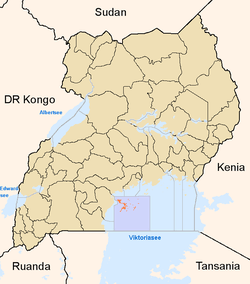Kalangala District
| Kalangala District | |
|---|---|
| District | |
 District location in Uganda | |
| Coordinates: 00°26′S 32°15′E / 0.433°S 32.250°ECoordinates: 00°26′S 32°15′E / 0.433°S 32.250°E | |
| Country |
|
| Region | Central Uganda |
| Capital | Kalangala |
| Area | |
| • Total | 9,103.0 km2 (3,514.7 sq mi) |
| • Land | 468.3 km2 (180.8 sq mi) |
| • Water | 8,634.7 km2 (3,333.9 sq mi) |
| Elevation | 1,240 m (4,070 ft) |
| Population (2012 Estimate) | |
| • Total | 66,300 |
| • Density | 141.6/km2 (367/sq mi) |
| Time zone | EAT (UTC+3) |
| Website |
www |
Kalangala is a district in southern Central Uganda. The district is coterminous with the Ssese Islands in Lake Victoria and does not have territory on mainland Uganda. Like other Ugandan districts, it is named after its 'chief town', Kalangala which is located on Bugala Island, the largest of the Ssese Islands.
Location
Kalangala District is bordered by Mpigi District and Wakiso District to the north, Mukono District to the northeast and east, the Republic of Tanzania to the south, Rakai District to the southwest, Masaka District to the west and Kalungu District to the northwest.[1] The district headquarters at Kalangala, are located approximately 60 kilometres (37 mi), across water, southwest of Entebbe, in Wakiso District.[2] The coordinates of the district are: 00 26S, 32 15E.
Overview
Kalangala District covers an area of 9,103 square kilometres (3,515 sq mi), of which only 468.3 square kilometres (180.8 sq mi) (5.1%) is land and the rest is open water. The district is made up of eighty four widely scattered islands in the northwestern part of Lake Victoria of which only forty three are inhabited. The biggest island is Bugala Island which covers 296 square kilometres (114 sq mi) or 63.2% of the district land mass.
Population
The 1991 national population census estimated the district population at about 16,400. Eleven years later, the 2002 national census estimated the population of the district at approximately 34,800, with an annual population growth rate of 6.8%. In 2012, it was estimated that the population of Kalangala District was about 66,300.[3][4]
The table below illustrates the growth trajectory of the district population during the first decade of the 21st century. All numbers are estimates.
| Kalangala District Population Trends | ||||||||||||||||||||||||||||
|---|---|---|---|---|---|---|---|---|---|---|---|---|---|---|---|---|---|---|---|---|---|---|---|---|---|---|---|---|
|
|
| ||||||||||||||||||||||||||
Economic activities
The three pillars of the district economy are: (a) fishing (b) tourism and (c) agriculture. The majority of the islanders depend a lot on fishing. The fishermen migrate following the seasonal movements of fish. Overfishing remains a concern.
Due to its location, its climate and its relative isolation, the district is a tourist magnet. Tourist facilities are rudimentary in most areas, although improvements in infrastructure (accommodations, road networks, communications, electricity supply, piped water etc.) are slowly improving.
Bidco Uganda, a private palm oil processor based in Jinja, maintains a controversial 15,000 acres (6,100 ha) palm oil plantation in the district. In addition, outgrower farmers grow palm oil on contract with Bidco and sell their produce to the processor.[5]
Livestock farming and logging are other economic activities practiced in the district. As of May 2014, it was estimated that the livestock count in the district stood as follows:[6]
Land insecurity
According to Friends of the Earth International (FEI), Oil Palm Uganda Limited (OPUL) is involved in a long running dispute over land with local communities in Uganda.[7] OPUL is 93 percent owned by Bidco Uganda, which itself is a joint venture formed by Wilmar International, Josovina Commodities, and Bidco Africa.[7]
According to The Guardian in March 2015, the land grabbing issue has plagued the community of Kalangala for a number of years. In July 2011 residents awoke to "find yellow machines churning up ... land and razing the crops ... grown in a bid to make way for palm oil plantations."[8] According to FEI, the project implications include forced displacement, poor labour standards, deforestation, and insecurity, amongst others.[9] The community has taken the venture to court.[7]
David Balironda, the Kalangala district production officer, said he saw people being compensated. When asked why he had not objected to the inadequate compensation paid, he said: “It was their agreement with the landlord. These people were squatters on someone’s land. They agreed on the amount of money. ... I blame the NGOs; it is them amplifying people to rise up and demand for land even when they were compensated.”[8]
See also
References
- ↑ Uganda District Map
- ↑ "Distance between Entebbe and Kalangala with Map". Globefeed.com. Retrieved 9 May 2014.
- ↑ "Estimated Population of Kalangala District In 1991, 2002 & 2012". Citypopulation.de. Retrieved 16 May 2014.
- ↑ "Growth of Kalangala Population Worries District Authorities". Uganda Radio Network Online. Retrieved 9 May 2014.
- ↑ Basaalidde, Nelson (1 July 2012). "Bidco Has Transformed Kalangala". Independent (Uganda). Retrieved 9 May 2014.
- ↑ "The Economy of Kalangala District". Uganda Travel Guide. Retrieved 9 May 2014.
- 1 2 3 http://www.foei.org/press/archive-by-subject/food-sovereignty-press/ugandan-oil-palm-conglomerate-taken-court-land-grab-claims
- 1 2 http://www.theguardian.com/global-development/2015/mar/03/ugandan-farmers-take-on-palm-oil-giants-over-land-grab-claims
- ↑ http://libcloud.s3.amazonaws.com/93/7b/3/3078/Issue_Brief_5_-_Wilmar_in_Uganda.pdf